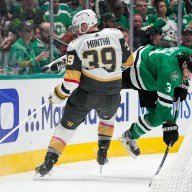Like so many Canadian boys, Gus Thorson of Calgary grew up playing hockey.
He had no idea he’d make a career of it.
Thorson played goal and quit the game at 17 — he’s now 50 — since he simply wasn’t that good.
But his friends were, and they played on the University of Calgary team while he was studying physical education there. The team needed some trainers — people to care for equipment, do first aid and help out in the locker room— and they encouraged Thorson to volunteer.
Two years later, the Calgary Canucks of the Alberta Junior League had issues with one of their trainers while going into the playoffs and called on Thorson. He ended up staying for the entire next season too. And he realized that this was something he could do as a real job.
“The more I did it, the more I learned. The more I learned, the more I liked it. There’s lots worse places you can spend your time than in a hockey rink.”
After graduation, Thorson got a paid job in Victoria, then Moose Jaw. Back in Calgary, he began splitting his time between working with Canada’s national hockey team and working in a sporting goods store where he became an equipment care and repair expert (his boss was a former shoemaker). After five years, he got hired as the full-time equipment manager for the national team.
In 1999, the Calgary Flames called, and he’s been there ever since.
Thorson works with four other trainers: They’re all in by around 7 a.m. most mornings. If the players are to skate at 10:30 a.m., that gives them time to stock the bench with socks, jerseys, pads, tape and water bottles. Then there are skates to sharpen, sticks to organize and last-minute repairs to do.
Then, it’s cleaning up after a practice. On game days, the locker room must be stocked by 4:30 p.m. Before a road trip, there’s packing to do.
And while he’s a pro at equipment repair, he now spends more time ordering custom equipment for his players, and making sure he gets the size and specifications just right.
“The biggest part of my job that’s changed is the amount of equipment we’re ordering. The way they make stuff now, it’s easy to break in, but it breaks down faster.”
And while his wife and kids get to see the Flames whenever they like, they don’t see much of him until summer.
Diane Peters once hawked magic pens at the Canadian National Exhibition. She’s now a writer and part-time journalism instructor.
















